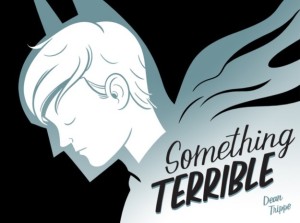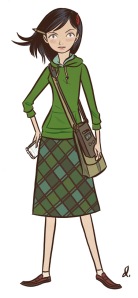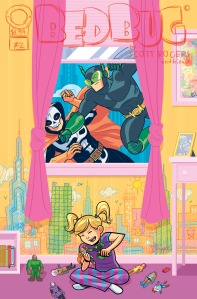
Dean Trippe is the kind of creator with such an obvious passion for comics, it’s enough to make the most dedicated of fans feel lazy. We all dislike a character costume at some point, but have you ever inspired a campaign of redesigns amongst fellow artists and fans like Dean Trippe did? I would love to see more all ages titles that are appealing to boys and girls; why haven’t I made one yet? And who wouldn’t want to read about the adventures of a young Lois Lane? One can still be an uber-fan without contributing to the betterment of comics, but Dean sure does make it look easy. Through his independently created comics, his love of the superhero genre has remained present, even while critiquing it.
Dean has always actively engaged with his fanbase throughout his career, first on Livejournal and more recently on Tumblr, giving us the occasional glimpse of what might have been. Though we can easily see and enjoy a new take on a costume, it is heartbreaking to read a pitch for a story like Lois Lane, Girl Reporter. More than simply showing us what a young version of the character would look like, the fully developed story outlines made the shortcomings of the current handling of the character glaringly obvious. We talked to Dean about his take on the character, his history with Lois Lane, and buying comics for his sisters. Keep an eye out in the next few weeks as we will also be posting a review of Dean’s newest comic, Something Terrible.
Megan Byrd: Let’s talk Lois. In discussing Lois Lane, Girl Reporter, your pitch for a young adult series that you worked on with artist Daniel Krall, you mention part of your inspiration stemmed from wanting to give your younger sisters comics with admirable female leads. Could you tell us a little bit about the books that you recommended to them growing up?
 Dean Trippe: Well, I have two sisters, one three years younger than me, and one twelve years younger than me, so they’re a little different, based on the books of the eras they were most into comics I brought them. Jenn, the older of the two, liked Robin’s ongoing title, Rogue’s miniseries, Generation X, and Nightwing. Melody’s favorite, far and away, was Spider-Man Loves Mary Jane and she also dug Batgirl: Year One. All of these titles featured cool characters who didn’t seem so boxed in to the mainstream notions of making the female heroes’ stories appeal to middle-aged, lonely men. They let the heroes be heroes, regardless of gender.
Dean Trippe: Well, I have two sisters, one three years younger than me, and one twelve years younger than me, so they’re a little different, based on the books of the eras they were most into comics I brought them. Jenn, the older of the two, liked Robin’s ongoing title, Rogue’s miniseries, Generation X, and Nightwing. Melody’s favorite, far and away, was Spider-Man Loves Mary Jane and she also dug Batgirl: Year One. All of these titles featured cool characters who didn’t seem so boxed in to the mainstream notions of making the female heroes’ stories appeal to middle-aged, lonely men. They let the heroes be heroes, regardless of gender.
MB: From today’s comic book offerings, what would you give your adolescent sisters to read?
DT: If I had to take comics from today back to their younger selves, I think I’d grab Young Avengers, the Miles Morales Ultimate Spider-Man series, Wolverine and the X-Men, and Batwoman. All top-notch comics that feature legacy characters written well.
MB: Lois Lane’s titular comic of the 60’s and 70’s featured more stories about her quest for marrying Supes than her investigative journalism. These books hold a place in many fans’ hearts for their silver age antics, but (most) fail to feature Lois in a positive light. Which Lois Lane stories appealed to you? Which creators do you feel have done this character justice?
DT: It’s tough, because as a Superman fan of the 90s, you know Superman loves Lois Lane, but it was hard for me to get my head around why. I mean, I liked that she was a reporter, but the portrayals I was most familiar with, Margot Kidder and Teri Hatcher, were kinda scattered and insubstantial in my opinion. It was Superman: The Animated Series that brought her back to her Golden Age roots for fans of that era. She was tough as nails, fearless, and had a fierce drive for getting the truth and sharing it with the public. She was ambitious and and clever. Her character was so attractive. Who wouldn’t want to be friends with someone that cool? So I’d have to say Paul Dini and Bruce Timm are the best folks to portray Lois, though they were drawing on her earliest appearances. Siegel and Shuster built the perfect partner for Superman, someone who fights for truth and justice without a secret identity or superpowers.
MB: Like Wonder Woman, Lois is a highly recognizable character that even the most casual comic book fan could describe; yet her stories are often at odds with the core values she represents. What do you think makes these iconic women such frequent victims of mischaracterization?
DT: It’s just the temptation of lazy writing to make her dumber than Superman, put her in life-threatening peril, and then have Superman scold her for not listening to him in the first place. I think so much of this nonsense is made without intending to be patronizing and offensive (though I’m sure some is), because it’s just the nature of writing supporting characters in a superhero title. I also think a lot of male writers haven’t come to terms with their own privilege and the responsibility of writing female characters with agency, so they’re acting out their conscious and subconscious views on women in four colors and two dimensions. Also, while many writers have handled Lois and Superman’s relationship well, I don’t think many had considered her his hero, as I pointed out in my pitch. When I figured that out, I understood them completely. Without that, I can see how some male writers are more excited by the visuals of Superman macking on Wonder Woman, even though his character’s backstory doesn’t naturally lead him to being attracted away from humanity.
MB: As a fan, when did you first become aware of the difference between the portrayals of your favorite male and female characters? Was it a particular story or character?
DT: I’d always sought out cool heroes with agency for me and my sisters, but it was fairly late when I became super aware of the bias against that for female characters. I’d been a Nancy Drew and Buffy fan, but it didn’t seem THAT weird to me to see positive portrayals of female heroes. It just seemed cool, like any other cool hero story. I didn’t really recognize how problematic the bias against that was until Stephanie Brown became the fourth Robin, and was then killed off, horrifically, with little to no effect on Batman and his allies. Just letting Spoiler–a character I’d been reading since her introduction–become the new Robin made me consider how big of a deal that was. And then they took it away. And were flat out abusive to the fans who felt betrayed by the death and the subsequent lack of acknowledgment. At the time, Supergirl was wearing this ridiculous non-costume designed for maximum male readership and was getting placed into stories where she had to make out with alternate universe counterparts for her cousin, and every male in her life had to show up and explain how she was doing everything wrong. Batgirl was being turned into a villain. It just kept going and going. My sisters weren’t as into comics by that point, but I was managing a comic shop, and I had female customers looking around like, “I don’t feel welcome in this world, anymore.” I’ve just always seen superheroes as a place for EVERYBODY to find safety and strength, so it was infuriating to see the company that had given me so much of both start denying it to female readers.
MB: Though DC decided to pass on your story pitch for Lois Lane, Girl Reporter, do you have any desire to create a similar creator owned story featuring a precocious female lead?
DT: Well, to be fair, they bought it, and we worked on it for three years before they laid off my editor, who was one of the only dudes inside the machine really fighting for female characters. But, yeah, I have a couple of female lead stories coming up in the next few years, one of which features a young, female adventurer. More on that soon.
MB: In addition to Lois Lane, what other licensed characters do you have a desire to write?
DT: I’ve kind of moved on from wanting to work on the properties, I think. There are too many limitations and conflicts in that realm. I’m happier just working on my own stories, I think, and my latest comic, Something Terrible, uses a digital release model I think I can replicate in the future.
MB: Why do you think properties (comics, tie in novels, cartoons, etc.) featuring female characters are still considered a “hard sell”? Has your work with any publishers indicated to you to you that this is changing?
DT: I don’t know why. It’s super dumb. I think most dudes in the position of making these calls haven’t wrapped their heads around the idea that women are over half of the population. I mean, it’s mind-boggling to me just from a money-making point of view. When they half-ass a female lead superhero flick like Elektra or Catwoman, then yeah, no one cares. But I really expect someone to crack the code soon, the way the Buffy show did in the 90s. And slowly, too slowly, I think there are more dudes who can identify with rad female leads like the new Captain Marvel or the old Veronica Mars show. We’re growing up. Slowly.
MB: A common retort to any critical view of comics is often “I’d like to see you do better!” I don’t think it’s a stretch to say that your work reflects certain qualities that are lacking in popular modern comics, whether it is through your character redesigns or with your all-ages friendly comics. Is it an accurate assumption to say that you are attracted to subjects with underutilized qualities?
DT: Maybe. I guess I just try to figure out what makes the character I’m considering at any moment, relevant in their world and relevant to me as a fan. Why would I care about Cassandra Cain if she’s turned evil? I don’t. What would feel new and exciting if Stephanie Brown came back? Where is there a niche not being explored? I always want to see characters look familiar so they feel like old friends, but also move the story forward, visually as well as in continuity. Dick Grayson, the first character to ever grow up in superhero comics, is a great model for how to keep a character relevant and exciting for decades. The current loss of so much continuity isn’t a strength, it’s a weakness all the DC titles are now saddled with. There are fewer toys, and the ones left matter less.
MB: Your work on Project: Rooftop has brought together many illustrators and fans alike sharing their love of costume design. Was your interest in redesign inspired more by the illustrator or fan in you?
DT: I guess it couldn’t possibly not be both. I think I have an eye for visually impressive pieces and a brain filled with stories about the characters to help me judge if they’re compatible. And I was a fan in the 90s, when there were so many redesigns coming out, good and bad. I love P:R. We’ve helped promote so many talented artists on their way up to the Big Two, and I couldn’t be prouder of lending that hand to get new, serious talent into mainstream comics.
MB: Was there a floodgate moment of “that costume is so awful, I know I can do better”?
DT: The early 00’s Supergirl was a serious breaking point for me.
MB: We hope to see a second volume of Power Lunch soon; what other projects are on the horizon?
DT: Yep! Power Lunch: Volume 2 will be out next year, and besides my new super-personal autobio comic, Something Terrible, which came out last week, my next projects are The Balance, a superhero team my five-year-old son and I have been working on, and then Butterfly Lark and the Possibles, which is going to be…a lot of work. Haha.

